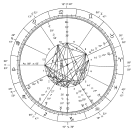Aquarius (astrology)
| Aquarius | |
|---|---|
 | |
|
| |
| Zodiac symbol | Water-bearer |
| Duration (tropical, western) | January 20 – February 19 (2016, UT1)[1] |
| Constellation | Aquarius |
| Zodiac element | Air |
| Zodiac quality | Fixed |
| Sign ruler | Saturn (ancient), Uranus (modern) |
| Detriment | Sun |
| Exaltation | Mercury |
| Fall | Pluto |
|
| |
| Astrology |
|---|
 New millennium astrological chart |
| Background |
| Traditions |
| Branches |
|
|
Aquarius (♒) (Greek: Ὑδροχόος Hydrokhoös, Latin: Aquārius) is the eleventh astrological sign in the Zodiac, originating from the constellation Aquarius.
The water carrier represented by the zodiacal constellation Aquarius is Ganymede, a beautiful Phrygian youth. Ganymede was the son of Tros, king of Troy (according to Lucian, he was also the son of Dardanus). While tending to his father's flocks on Mount Ida, Ganymede was spotted by Jupiter. The king of gods became enamored of the boy and flew down to the mountain in the form of a large bird, whisking Ganymede away to the heavens. Ever since, the boy has served as cupbearer to the gods. Ovid has Orpheus sing the tale:
"The king of the gods was once fired with love for Phrygian Ganymede, and when that happened Jupiter found another shape preferable to his own. Wishing to turn himself into a bird, he none the less scorned to change into any save that which can carry his thunderbolts. Then without delay, beating the air on borrowed pinions, he snatched away the shepherd of Ilium, who even now mixes the winecups, and supplies Jove with nectar, to the annoyance of Juno" (Metamorphoses X 154-160).
Aquarius is a summer constellation in the northern hemisphere, found near Pisces and Cetus. It is especially notable as the radiant for four meteor showers, the largest of which is the Delta Aquarid meteor shower in late July and early August.
Under the tropical zodiac, the sun is in Aquarius typically between January 20 and February 18, while under the Sidereal Zodiac, the sun is in Aquarius from approximately February 15 to March 14, depending on leap year.[2]
References
Notes
Works cited
- Allen, Richard Hinckley (1899). Star-names and their meanings. G. E. Stechert. OCLC 1285139.
- Almanac for the year 1386. C. Stower Hackney. 2008 [1812]. OCLC 500148918.
- "The Aquarius Myth - The Story Behind the Constellation Aquarius". Gods-and-monsters.com. January 14, 2015. Retrieved February 6, 2015.
- Astronomical Applications Department (2011). Multiyear Computer Interactive Almanac. 2.2.2. Washington DC: US Naval Observatory. Longitude of Sun, apparent geocentric ecliptic of date, interpolated to find time of crossing 0°, 30°....
- Heindel, Max (1919). Simplified Scientific Astrology: A Complete Textbook on the Art of Erecting a Horoscope, with Philosophic Encyclopedia and Tables of Planetary Hours (4th ed.). Rosicrucian Fellowship. OCLC 36106074.
| Wikimedia Commons has media related to Aquarius (astrology). |